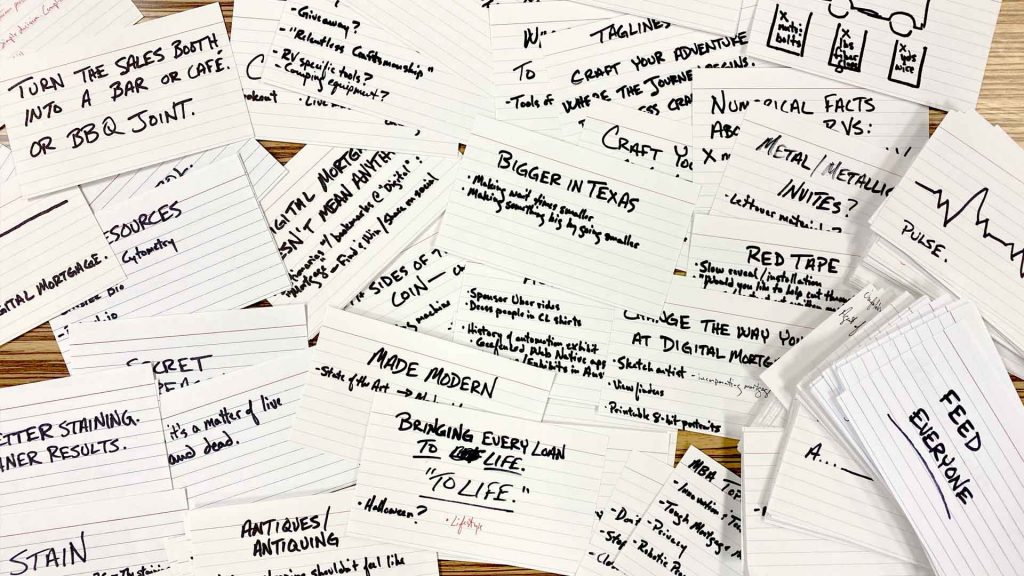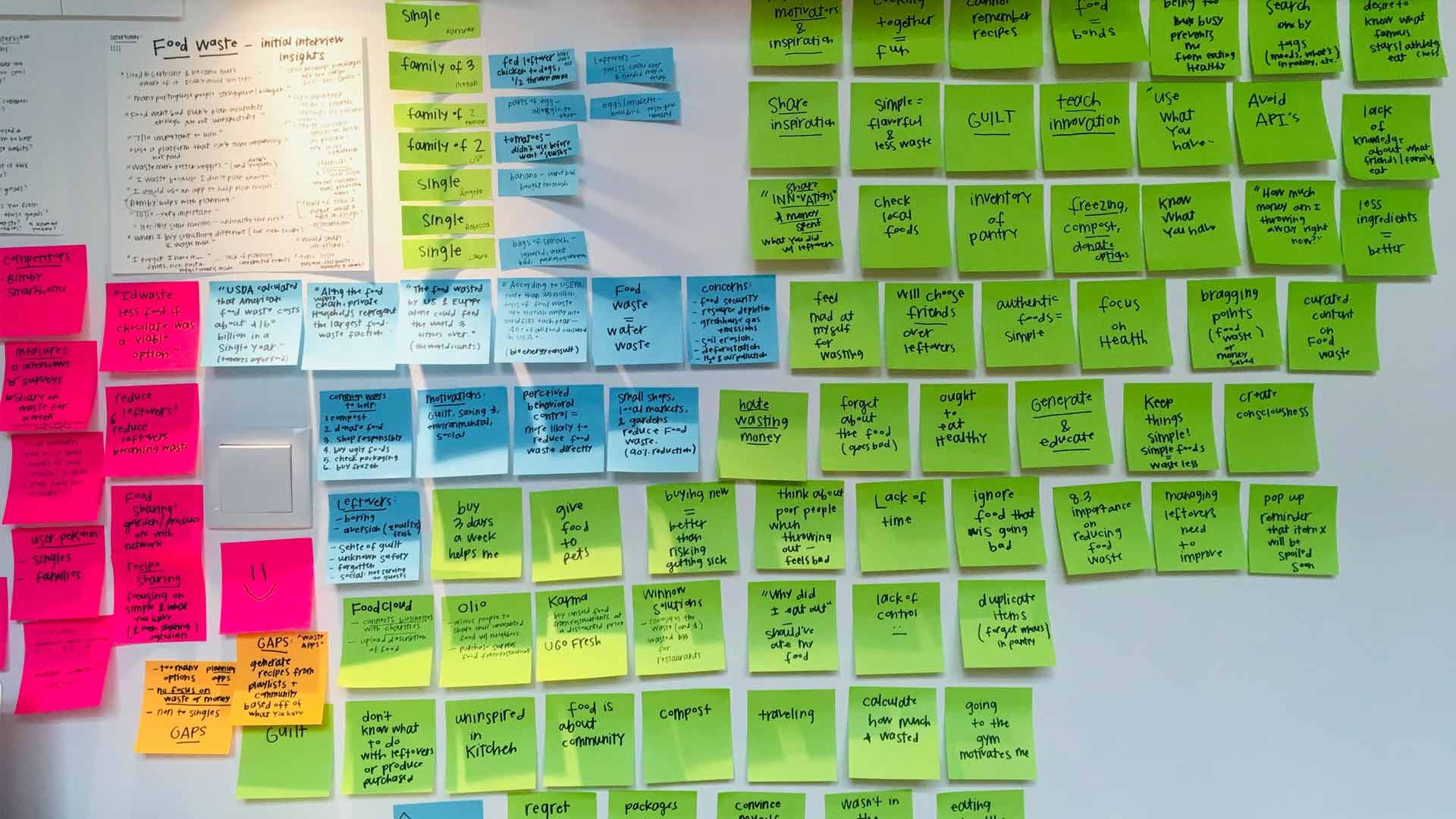Let me start this by saying no one creative concepting process is right—and the one outlined below is hardly the only one. Every creative type in this building (and in every other agency environment) has their own way of concepting that they were taught and that works for them. Respect the process.
I’ll also caveat this by saying that while these processes are behind a lot of great ideas, they’re behind a lot of terrible ideas, too. Such is the nature of creative work. Oh well.
Creative Brief
The creative “brief” (quotes mine) is considered a kind of contract between the creative department, the account team, and the client. It’s also the basis for every bit of creative work that comes out of an agency. It keeps the creative team wrangled a bit (something that most of us will bemoan loudly and frequently, while knowing secretly we all need some kind of guardrails to operate within).
The “brief” is rarely so, for better or worse. Seems there’s always a lot of very important information that the account team wants us to convey. As a copywriter, I find it helpful. The more information to draw ideas from, the better. The wider the net I’m able to cast, the more ideas I’m able to dredge up. I think my metaphor got a bit muddled, but you get it.
At its core, the brief should tell us three things:
- Who we need to convince
- What we need to convince them of, and
- Why they need to be convinced
There are other elements, like what we want an audience to think, feel, and do. Or certain reasons why a particular product is better than other particular products. Marketing and advertising are meant not to sell, necessarily, but to stir emotions and move an audience to action.
The brief kickstarts my creative process. But more on that later.
Index Cards
While I don’t think this method is rare, per se, I have received no small amount of eye-squinting stares for concepting with index-style notecards. Early on in my career, I was set to concept with a senior copywriter and an art director for a new account we landed. My creative director walked up to my desk, dropped a giant stack of index cards in front of me, and said, “Fill them out.” He turned around.
“All of them?” I asked after him.
“Every one of them,” he said over his shoulder as he walked back out.
In that moment, the giant stack of index cards was the most daunting thing I’d seen in my career. Now, I view it as an empty stack of ideas. Concepting is my favorite part of my job—and I really enjoy my job.

A few of the hundreds of notecards I’ve filled out to find a single idea.
My first step is to sit down with the brief and a highlighter. I go through it and mark any interesting phrases, words, statistics, potential media buys, and key elements that might spark anything.
Then come the notecards and a sharpie. I may write down some of the highlighted words from the brief, just to get things started. I might try to find interesting connections between those words and other things. I might look for a story arc among them. I will inevitably—regretfully—think of a dozen or so puns (more on a bad day). I write them all down. If you don’t get them out, they’re all you’ll think of. So onto notecards they go, often with a “Sorry…” written beneath them.
What I’m looking for most are places where all of these words and ideas converge. Some of these notecards turn into full-fledged conceptual thoughts. Others stay as words, because they may spark something in me later—or better yet, in an art director partner when we sit down together.
When I inevitably get stuck and simply can’t drag another idea out of my thoroughly wrung mind, I’ll pop open one of the several books I keep on my desk. Usually it’s Hey Whipple, Squeeze This by Luke Sullivan. If you’re even remotely interested in advertising, marketing, the creative process, or you’re in a relationship with a creative and can’t understand why they come home so dejected and distracted every night, I recommend you read it.
Concepting
Remember up there when I mentioned that everyone concepts a little differently? I’ve outlined my process, which is to sit alone somewhere and furiously scribble until I have some small semblance of what may constitute an idea. Then I’ll get together with an art director (and sometimes digital manager and/or web developer) and we’ll go over every idea, collectively. It’s a process. And usually one that nets more than one good idea, and several more with legs.
You’ve heard the phrase “throwing things at a wall and seeing what sticks”? That’s this. That’s exactly this.
In my process, I tape my notecards to the wall. Then a partner and I go through them and talk through each one. We flesh each one out, see how others can work both visually and in practice. Other creatives, on the other hand, don’t like to concept alone. They prefer to sit down together at the beginning. They talk about movies, BS about their kids, think about odd scenarios in which strange occurrences may actually happen. Out of this chaos, somehow, ideas manifest.
After my partner and I have thought through our ideas (there’s no self-editing at this point; every idea is viable), we invite a creative director to come in and wreck things. In like a tornado and rarely like a lamb, a CD comes in, listens to our pitches, and tells us which one he or she thinks has legs, which ones may work in another life, and which ones we should feel bad about for even having thought of.
“Hey, wouldn’t it be funny if we did…” And ta-da. There you have it. Something that might just turn into the next big marketing campaign that turns a client’s year around.
Or maybe not. That’s why we test things to see.
Blowing It Out
Once we’ve narrowed things down to a handful (usually five, at this stage), we set to blow out the concepts. This means mocking up, faking, making, writing, creating, and building “proof of concept.” This is where we prove that a concept works—and it’s as much for us as it is for a client.
In this stage, another two or three concepts may die. The idea may exist, and it may be perfectly viable, but it’s not manifesting as well as the other ideas are. It just doesn’t have a strong showing.
We try to find all the ways a concept might live: print and digital ads, sales and marketing materials, direct mail, video and pre-roll, programmatic radio, and any other zany, previously unthought-of ideas that may work within a theme. We build them to an extent, not ready to run but to give an idea of how the concept may look out in the world.
I’ve woken up from terrible dreams that have made for good campaigns. A good idea is one that stretches you outside your comfort zone and finds a way to connect with audiences in ways you haven’t thought of before. And speaking for the creative department: ideas are what we do.





